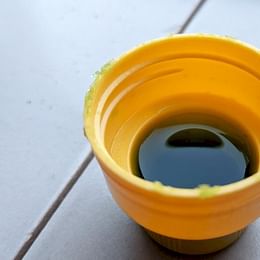How to care for a Ficus Elastica (Rubber Tree)
With its large, almost water-colored, leaves, the Ficus Elastica (also know as the Rubber Plant or Tree) is a plant you can't miss. In this plant care guide, we're going to look at how you can keep your Ficus Elastica happy and healthy.
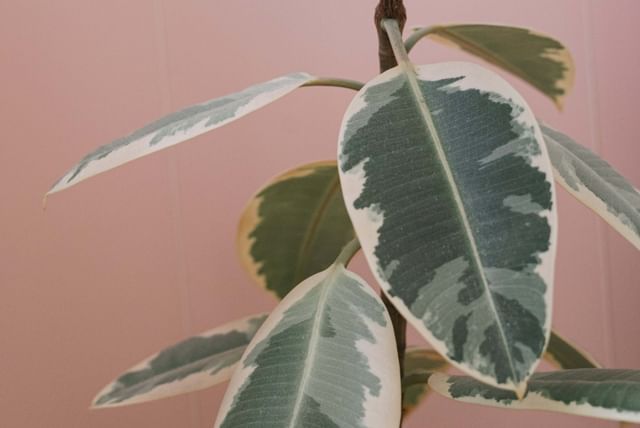
With its large, almost water-colored leaves, the Ficus Elastica (also known as the Rubber Plant or Tree) is a plant you can't miss. Its leaves don't look like they could be real, but luckily for us as plant enthusiasts, it's a very real plant!
The Ficus Elastica is native to India and Indonesia, so it's used to higher temperatures and lots of humidity. If you're just starting out with houseplants, you might want to hold off on taking care of this plant for a little bit. It's not the easiest plant to start your journey with. Instead, you might want to have a look at a Monstera or Alocasia. These are great plants to start with before giving the Ficus Elastica a try.
In this guide, we're going to look at how you can take care of this plant and how you can keep it happy.
We'll go over these topics:
- How do you water a Ficus Elastica?
- What are the light requirements of a Ficus Elastica?
- What are the best temperature and humidity ranges for Ficus Elastica?
- What is the ideal soil mix for a Ficus Elastica?
- What is the right type of pot for a Ficus Elastica?
- How often should you repot a Ficus Elastica?
- How often should you fertilize a Ficus Elastica?
- When and how do you prune a Ficus Elastica?
- How do you propagate a Ficus Elastica?
- Plant care tips for different seasons
- Common pests on Ficus Elastica
- Diseases on Ficus Elastica
- Is a Ficus Elastica toxic to pets?
- Plant care differences between young and mature Ficus Elastica plants
- Common myths about Ficus Elastica care
- Myth 1: Ficus Elastica needs direct sunlight
- Myth 2: They are toxic to humans
- Myth 3: They don't need watering in winter
- Myth 4: Ficus Elastica can't adapt to different environments
- Companion plants to Ficus Elastica
- 1. Pothos (Epipremnum aureum)
- 2. Dracaena
- 3. Spider Plant (Chlorophytum comosum)
- 4. Peace Lily (Spathiphyllum)
- Conclusion
Let's dive right in and let's learn how we can take care of a Ficus Elastica or Rubber Tree in your house!
How do you water a Ficus Elastica?
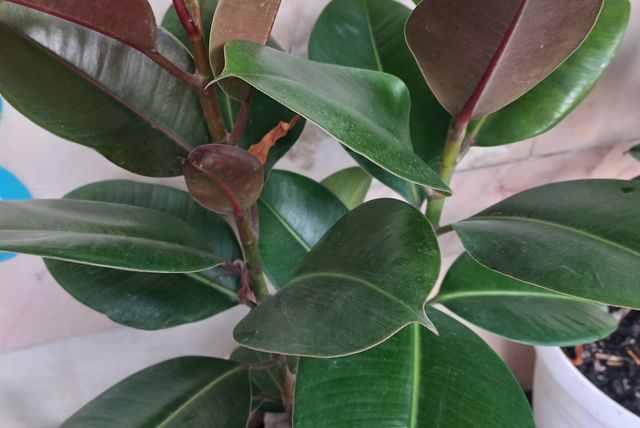
The Ficus Elastica is a plant that's very sensitive to overwatering. It doesn't like to be wet, but also doesn't do well when it's in dry soil. It's best to keep its soil lightly moist most of the time and you should water it when the top 2.5 cm (1 inch) of the soil is dry. It's important to check whether the top of the soil is dry before you water because this will help prevent overwatering your plant.
How often you should water your Ficus Elastica depends on a lot of things, but on average, you should water your plant once per week in the summer and once every 2 weeks in the winter. This time can take longer if your house is colder or more humid, or you might have to water it more often if your house is warm and dry.
Your Rubber Tree is very sensitive to overwatering, so when you have accidentally overwatered it, you can expect leaves to fall off. These leaves will turn yellow first and then brown, before falling off.
When you notice the leaves turning yellow and brown, make sure to stop watering and let any excess moisture drain out of the pot. If the soil isn't draining properly, it's also a great idea to repot your plant in soil with excellent drainage.
What are the light requirements of a Ficus Elastica?
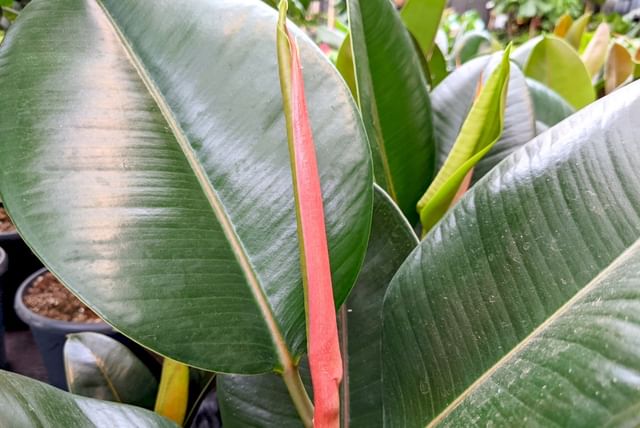
When it comes to sunlight, your Ficus Elastica can tolerate quite a large range of sunlight exposure. It can tolerate low light, but if you want it to thrive in your house, you'll need to give it bright, indirect sunlight.
Put it in a spot that gets some direct sunlight but not too much. A great place for your Ficus Elastica can be near a window that gets direct sunlight in the morning, but none during the hottest hours of the day.
If you don't have a spot like this, you can also put it a few meters away from a south-facing window. This way, your Rubber Tree won't get scorched by the sun and will still get enough light to grow strong. You can also consider using sheer curtains to filter the direct sunlight and make it less intense for your Ficus.
Also, think about the temperature and humidity levels in the spot you choose; a constant and warm environment away from drafts and heating vents will help your plant to stay happy.
Check out different kinds of light, and tips for each type to help your Ficus Elastica thrive: What is the difference between direct, indirect, and low-light sunlight for plants?
What are the best temperature and humidity ranges for Ficus Elastica?
When taking care of your Ficus Elastica, figuring out what kind of temperature and humidity levels it likes makes it much easier to keeping it healthy. This plant loves a warm, constant environment, so it's perfect for use as a houseplant.
Ficus Elastica does best in temperatures between 15 to 27 degrees Celsius (60 to 80 F). As with most other plants, it's important to avoid extreme temperature changes, so keep it away from cold drafts or direct heat sources like radiators and heating vents.
Since Ficus Elastica is from a tropical place, it shouldn't come as a surprise that it enjoys a bit of moisture in the air. It does quite well in the normal humidity levels in your house, ideally between 40% and 60%.
Measure the humidity levels
If you're unsure how to measure the humidity in your home, it's actually quite simple and can be done using a few different methods. The most accurate and straightforward way is to use a hygrometer, a device specifically designed to measure relative humidity levels. You can find cheap digital hygrometers at home improvement stores or online. Simply place the hygrometer in the room you want to measure, and it will display the humidity level, usually as a percentage.
If you don't have a hygrometer on hand, you can also use some DIY methods for a rough estimate. One popular trick is the "ice water test": fill a glass with ice and water, let it sit for about four minutes, then check the outside of the glass. If condensation forms, the humidity is relatively high. If the glass remains dry, your indoor air is likely low in humidity.
While these methods won't give you a precise reading, they can help you guess whether you need to increase the humidity for your Ficus Elastica.
How can you increase humidity if needed?
Higher humidity can make all the difference for your Ficus Elastica, especially during dry seasons, like winter (central heating makes the air dry). This plant thrives in a humid environment, so if you notice signs of low humidity, like browning leaf edges or drooping leaves, it's time to jump into action.
One simple way to boost humidity is to use a humidifier in the room where your plant lives. This not only helps your Ficus Elastica but can also improve the overall comfort of your home. If you don't have a humidifier, try placing a shallow tray filled with pebbles and water beneath your plant's pot. As the water evaporates, it will create a more humid microclimate around your plant.
Misting the leaves with water regularly can also help, but make sure not to overdo it, as too much moisture can lead to mold and other issues. By keeping humidity levels in check, you'll create the perfect environment for your plant to thrive!
If you're looking for more ideas to raise the humidity to keep your Rubber Tree happy, check out 10 ways to raise the humidity in your house
What is the ideal soil mix for a Ficus Elastica?

Earlier, we discovered that the Ficus Elastica is quite sensitive to overwatering.
To help your plant stay healthy and prevent overwatering, you should use well-draining soil for your Ficus Elastica. Keep in mind that your Ficus still likes to grow in soil that's lightly moist most of the time, so it shouldn't drain all of the moisture right away. It should hold onto some moisture for a few days.
The perfect soil mix for a Ficus Elastica is soil that contains things like peat moss or coconut coir to retain moisture for a few days. The soil should also be well-draining, so you can add things like Perlite, Leca, or Smart Gravel.
By mixing 1 part of the moisture-retaining ingredients with 1 part well-draining ingredients and 1 part general potting soil, you'll have soil that retains moisture but drains any excess moisture to the bottom of the pot. This helps your plant stay hydrated, but not get overwatered.
The peat moss, coconut coir, perlite, Leca, and Smart Gravel also add some structure to the soil. This helps the soil to stay light and fluffy, letting oxygen flow freely to your plant's roots.
If you want to find out more about helping your soil retain more moisture, "How to make your soil retain more water?" might help you.
What is the right type of pot for a Ficus Elastica?
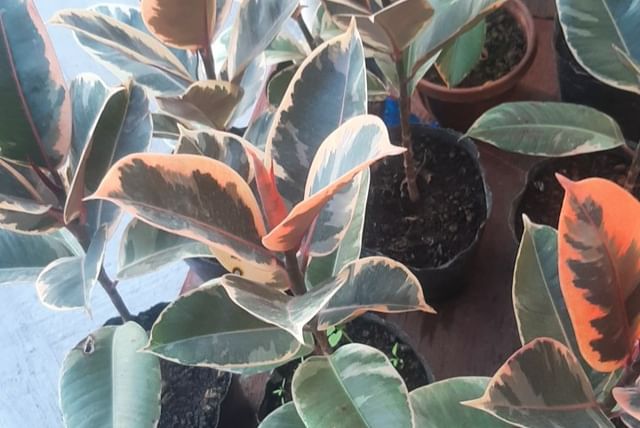
In this plant care guide, I've mentioned a few times that the soil will drain any excess water to the bottom of the pot. If you're using a pot without a drainage hole, the excess moisture will stay in the pot and your plant will stand in a puddle of water. We don't want that to happen, because this helps root rot to develop.
The perfect pot for a Ficus Elastica is a pot with drainage holes. These drainage holes prevent the excess moisture from staying behind in the bottom of the pot. The drainage holes help the moisture to escape the pot, so your plant is never standing in a puddle of water.
So your Ficus doesn't like to have wet feet, what does this mean for choosing a pot? It means that you should choose a pot that can get rid of moisture quickly. The best type of pot that helps you get rid of excess moisture quickly is a terracotta pot. This type of pot evaporates excess moisture quickly and helps your soil breathe. Plus most terracotta pots have a drainage hole, so its ideal for your Ficus Elastica!
How do you choose the right size pot?
So the ideal pot is a terracotta (or ceramic) pot with a drainage hole, but how do you choose the right size? And does the size of the pot matter?
The short answer is yes. The size of the pot is very important for your plant's health. Pots that are too large hold onto a lot of moisture, moisture your plant can't all absorb within a week. This moisture will stay behind and will cause your plant to be overwatered which might lead to root rot.
The ideal pot size is a pot that's 2-5 cm (1-2 inches) larger than the root system of your plant.
A pot that's slightly larger than the root system of your Ficus Elastica gives it enough space for the plant to continue growing, but also makes it much easier to prevent overwatering your plant.
How often should you repot a Ficus Elastica?
When your Ficus Elastica has been growing bigger than expected or there is simply not enough room in its current pot, it's time to repot it. Signs that your Ficus needs repotting include yellowing or wilted leaves, roots poking through the drainage holes of its pot, and slow growth.
As we've already discovered earlier on in this plant care guide, we should find a pot that's only slightly larger than its root system to prevent overwatering. When you're repotting your Ficus into a bigger pot, find a pot that's one size up or around 2-5 cm (1-2 inches) larger on each side. This will give your plant plenty of space for new growth.
On average, you should repot your Ficus Elastica once every 1-2 years depending on how quickly your plant is growing.
How do you repot a Ficus Elastica?
Repotting your Ficus Elastica is a great way to give it fresh soil and more space to grow, and it's quite an easy process! Start by choosing a new pot that is 2-5 cm (1-2 inches) larger in diameter than the current one. Make sure it has drainage holes to prevent water from accumulating, which can cause root rot.
Begin the repotting process by gently removing the plant from its current pot. You may need to tap the sides or squeeze the pot if it’s tightly bound. Once out, carefully loosen any compacted roots and remove any dead or rotting root sections. Next, place a layer of fresh potting soil at the bottom of the new pot, then set the Ficus in, adding more soil around the sides until the plant is securely in place.
Water it well after repotting to help settle the soil. In the following weeks, you might notice your plant showing some signs of stress, like dropping leaves. This is normal, because your plant needs to adjust to its new home. Don't, I truly repeat, don't handle your plant in the first few weeks. If you keep adjusting something, the plant will take a longer time to get used to it's new pot.
How often should you fertilize a Ficus Elastica?
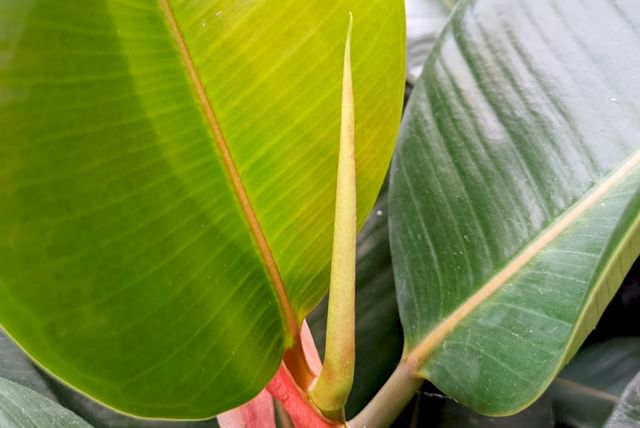
Your Ficus Elastica is a plant that grows quite quickly. In its natural growing environment, in India and Indonesia, it grows very tall, usually several meters tall. Indoors, it can also grow tall and it's up to you how tall you allow it to get. If you like its height, you can trim the plant back and/or propagate it.
Your Ficus Elastica grows quickly, which means you need to fertilize it occasionally. During the growing season, the spring and summer, you should fertilize it around every 4-6 weeks with liquid fertilizer. When you fertilize it regularly, you help it to grow healthy and you make sure the plant has enough energy to put out new leaves. During the autumn and winter months, when your Ficus Elastica enters its dormant phase, it's a good idea to hold off on fertilizing altogether, allowing the plant to rest.
The right dosage of fertilizer
When you fertilize your Ficus Elastica with a liquid fertilizer, make sure to dilute it with the water your use to water your plant. This is convenient but also helps you to prevent over-fertilizing your plant. Overfertilizing your plant could cause a chemical burn on your plant's roots and will kill it if you don't drain the excess fertilizer from the soil.
Draining the excess fertilizer from the soil is quite easy if you use a pot with drainage holes: Water your plant deeply and let the excess moisture drain from the pot for around 5 minutes. Your plant is now properly watered and any excess fertilizer will have drained from the pot. Win-win!
If you're not using a liquid fertilizer, you can still fertilize your Ficus Elastica with a slow-release or granular fertilizer. Usually, this type of fertilizer lasts for 100 days, or roughly 3 months. When you apply a slow-release fertilizer, simply sprinkle it on top of the soil or mix it in while you're repotting your plant.
Be sure to follow the package instructions for the right amount, as over-fertilizing can harm your plant.
When and how do you prune a Ficus Elastica?
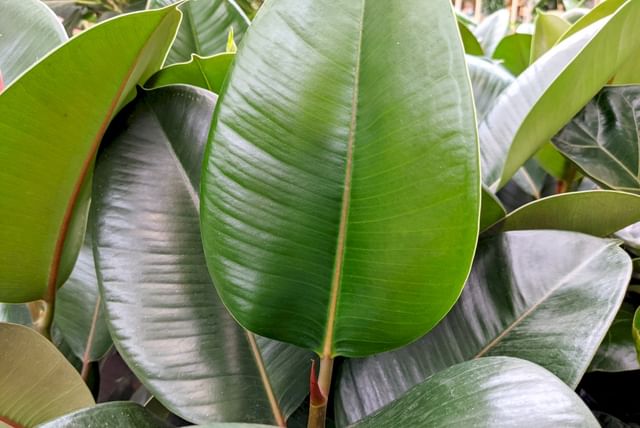
Pruning seems like a scary thing to do to your plant, but it has many benefits. Pruning may help shape your rubber tree by removing any dead leaves or branches. By pruning these dead leaves and branches, your plant not only looks better, but it's also a great way to prevent pests from getting to your Ficus.
Pruning encourages growth by cutting off parts of stems and branches, increasing the number of nodes over time.
The best time to prune your Ficus is during the spring because it'll be the growing season for your plant and it'll have months to recover and grow afterward. During the fall and winter, your Ficus won't grow (as quickly), so this isn't the right time to prune your plant. Unless you're pruning dead leaves or branches, you can prune those all year round.
When you prune your Ficus, be sure to not remove too much of your plant at once, as this can cause harm and shock your plant.
Cut-off stems can then be used for propagation; each stem cutting can be potted separately in its own container and grown out to become an adult plant. Let's look at that a little more!
How do you propagate a Ficus Elastica?
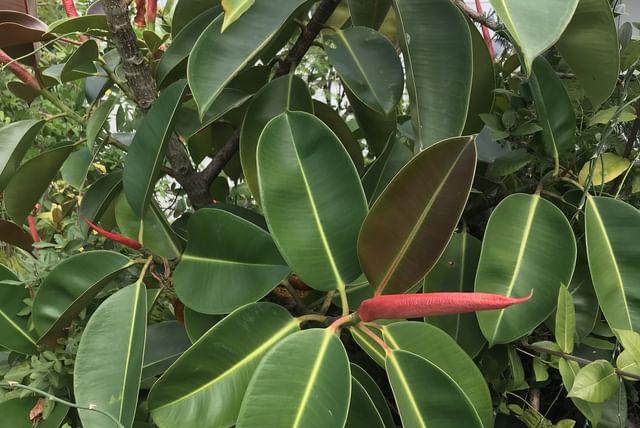
When you've pruned your Ficus Elastica and you've got one or more stems, you can propagate these to grow new plants. Propagating a rubber tree through stem cuttings is quite easy!
Cuttings of a Ficus Elastica need a lot of humidity to start growing roots, so you'll need to prepare a pot with the right growing environment.
Begin by carefully cutting off a side branch around 7-10 cm (3-4 inches) long from the main plant. You can also remove individual leaves, as you can also propagate these.
Take your cutting and put this in a glass of water while you prepare your pot. This will prevent the cutting from drying out. Prepare the pot with well-draining, but moist soil and put your cutting in the soil. Take a small Ziploc bag, or a larger see-through plastic bag if your cutting is larger, and place this over the cutting.
This plastic cover will trap humidity and provide your Ficus cutting with the ideal growing environment. Make sure to put your plant with the plastic bag in a bright spot, but not in direct sunlight.
After a month or so, you should start to see roots growing and you have successfully propagated your Ficus Elastica. At this time, you can also remove the plastic bag and care for it as if it were any normal Ficus.
Plant care tips for different seasons

Plants can feel the seasons change. I know how that sounds, but it's true! Spring brings more sunlight and slightly higher temperatures, summer is full sun and high temperatures, and in the fall and winter, the sun becomes weaker and weaker.
The plants also grow differently throughout these seasons, which means you also need to change your care routine slightly. Let's break down how to care for your Ficus Elastica in spring, summer, autumn, and winter to make sure it gets the right attention all year round.
Spring
As spring arrives, your Ficus Elastica will start its active growth phase. This is the perfect time to water a little more, as the plant will need more moisture to grow new leaves. Be sure to check the soil regularly, and water when the top inch feels dry. It's also a good idea to start fertilizing using a balanced liquid fertilizer every few weeks, as this will provide the nutrients your plant needs to grow. Spring is also an ideal time to inspect your plant for any signs of pests, giving you a chance to catch any issues early.
If you need to repot your plants, spring (but also summer) is the perfect time to do so!
Summer
During the warm summer months, your Ficus Elastica will thrive in bright, indirect light. Ensure it gets plenty of light by placing it near a window with filtered sunlight. But if it's getting direct sun, you might want to move it to avoid leaf scorching. Your plant will still need a lot of moisture in the hot summer, so continue to check the soil moisture closely.
You might also want to increase humidity during this time, especially if you're running air conditioning, as dry air is not good for most of your plants, including your ficus. Regular misting or using a humidifier can give your plants this extra humidity.
Autumn
As the days shorten and temperatures begin to drop in the autumn, your Ficus Elastica will slow down its growth. It's a good idea to water your plant less during this time, allowing the topsoil to dry out a little more between waterings. Keep an eye on your plant and ensure it's still getting enough light. Usually, you'll want to move your plants closer to windows in autumn. Direct sunlight is completely fine this time of year, as the sunlight is much weaker than during the summer. Autumn is also the right time to stop fertilizing, as the plant won't need as many nutrients during its dormancy phase.
Winter
In winter, the care for your Ficus Elastica becomes all about maintaining its comfort during cooler months. Keep your plant in a stable environment away from drafts and direct heating sources to prevent stress. During this time, water your plant even less and make sure the plant's soil is on the drier side, as it won't need as much moisture when growth slows.
Keep humidity levels in check, as indoor heating can dry out the air; using a humidifier or pebble tray can help maintain a humid environment around your plant. If your Ficus isn't getting enough natural light, consider using grow lights to give your plant a bit of extra light during these darker months.
In the spring, explosive growth will come back, you'll see!
Common pests on Ficus Elastica
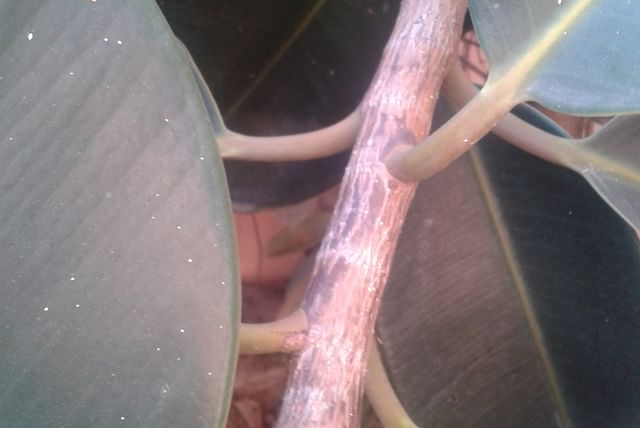
Ficus Elastica are generally pretty tough, but some pests are tougher. Keeping an eye out for these pests and knowing how to get rid of them is important to keeping your plant healthy for many years. Here are the most frequent pests to watch for, along with tips on how to spot and treat them!
Spider Mites
Spider mites are tiny arachnids that can be particularly problematic for Ficus Elastica. They are often difficult to see with the naked eye, but you might notice tiny webs on the undersides of leaves or between branches. If you inspect the leaves closely, you may see tiny, moving specks. Those are the mites themselves!
Signs of spider mite infestation include yellowing leaves, speckled foliage, and leaf drop, which can be alarming.
To treat spider mites, start by rinsing the affected leaves with a gentle stream of water to dislodge the pests. If the problem continues, you can treat your plant with neem oil or insecticidal soap, both of which are effective against spider mites. Make sure to treat both the tops and undersides of the leaves, as that's where these pests tend to hide. Repeating this treatment every week can help keep them at bay.
Mealybugs
Mealybugs are another common pest that can affect Ficus Elastica. These small, white, cottony masses are often found in the leaf axils or at the base of the stem. You might also notice a sticky residue on the leaves, known as honeydew, which is a byproduct of mealybug feeding.
Signs of a mealybug infestation include wilting and yellowing leaves, as well as a general decline in the plant's overall health.
To manage mealybugs, start by isolating the affected plant to prevent the infestation from spreading to your other houseplants. You can remove mealybugs by gently wiping them off with a cotton swab dipped in rubbing alcohol. For a more extensive infestation, consider using insecticidal soap or neem oil, applying it thoroughly to the plant.
Regularly checking your ficus is key to catching them early, as these infestations can grow and spread quickly.
Scale insects
Scale insects can be a sneaky pest on your Ficus Elastica. They appear as small, brown or black bumps on the stems and leaves, and they can sometimes be mistaken for small pieces of dirt. When they feed, they suck the sap from the plant, leading to yellowing leaves and stunted growth. You might also see a sticky residue or sooty mold developing on the foliage, which are signs of a scale infestation.
To get rid of scale insects, you can remove them manually by scraping them off with a soft cloth or your fingernail. For larger infestations, applying neem oil or insecticidal soap can help eliminate them. Make sure to cover all parts of the plant, focusing on the undersides of leaves and hidden areas where scale likes to hide. Regularly inspecting your Ficus Elastica will help you catch scale early and keep your plant looking its best.
Diseases on Ficus Elastica
Even though Ficus Elastica is a tough plant, besides the pests from the previous section, it can suffer from a few common diseases as well. Recognizing the signs of these diseases early is crucial to helping it recover. Below, we'll go over the most common diseases that can impact your Rubber Tree, along with ways to identify them and notice if your plant is feeling under the weather.
Root rot
Root rot is a common issue for Ficus Elastica and is caused by overwatering or poor drainage. This disease develops when the roots sit in waterlogged or wet soil for too long, so they start to rot. Signs of root rot usually include yellowing leaves, wilting, and an overall sad appearance. If you gently tug on the plant and it feels mushy or easily pulls out of the pot, it's a good sign that your plant is suffering from root rot
To combat root rot, the first step is to carefully remove the plant from its pot and inspect the roots. If you find any dark, mushy roots, trim them away with sterile scissors. Repot your Ficus in fresh, well-draining soil and a pot with drainage holes. Going forward, adjust your watering routine, ensuring that you allow the top inch of soil to dry out before rewatering.
Leaf spot
Leaf spot is a fungal disease that can affect Ficus Elastica, presenting as small brown or black spots on leaves. These spots may have yellow halos around them and can lead to leaf drop if left untreated. This disease is caused by overly wet conditions, high humidity, or poor air circulation. If you notice your plant developing these spots, it's a clear sign you need to take action.
To manage leaf spot, begin by removing any affected leaves to prevent the disease from spreading. Be sure to improve air circulation around your Ficus by placing it in a location with better airflow. Adjust your watering routine, allowing the soil to dry out between watering sessions, and avoid getting water on the leaves directly.
Powdery mildew
Powdery mildew is another fungal disease that can attack your Ficus Elastica, and looks like white, powdery spots on the leaves. It thrives in high humidity and poor air circulation, often appearing when temperatures change a lot between day and night. Infected leaves can also turn yellow over time.
To manage powdery mildew, start by improving air circulation around your plant. Make sure that it's not overcrowded with other plants and that it gets plenty of light. You can also treat it with a fungicide specifically designed for powdery mildew or even a homemade solution of a mild soap and water spray.
Is a Ficus Elastica toxic to pets?
Your Ficus Elastica has a fitting nickname: Rubber Tree. This name is fitting because your plant's sap contains latex. Because the sap contains latex it's considered to be toxic and you should keep it away from pets and young children.
However, if you have some pet reptiles, like chameleons, a rubber tree is a popular tank setup for them. With its thick and glossy green leaves and strong stems, perfect for climbing, this plant can easily become the center of the entire habitat.
If you have a latex allergy, be careful when handling this plant. It's important to wash your hands after handling this plant or wiping down its leaves.
Plant care differences between young and mature Ficus Elastica plants
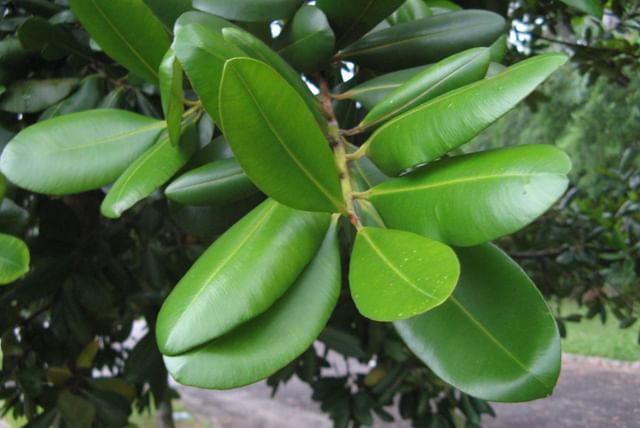
Young and mature Ficus Elastica plants have slightly different plant care needs. Here's what you need to know about adjusting you care routine as your plant gets a little older.
Young Ficus Elastica plants need a bit more attention when they're trying to grow. These younger plants tend to dry out faster, so you'll need to keep a closer eye on soil moisture, watering them more often, but making sure the plant doesn't get overwatered. This is especially important because young plants generally have smaller root systems, meaning they are more susceptible to overwatering and root rot.
Also, young plants need brighter (indirect) light conditions to encourage strong, healthy growth. Don't give them any direct sunlight, because the young leaves are much more sensitive to this type of sunlight than mature leaves. Fertilizing every 4-6 weeks during the growing season can also help give them the nutrients they need to thrive.
On the other hand, mature Ficus Elastica plants are generally tougher and can handle a bit of neglect when it comes to care. Their established root systems allow them to go longer between waterings, so it's essential to allow the top layer of soil to dry out before watering again. Mature plant still like bright, indirect light, but they can also grow in lower light levels, making them more forgiving if you need to relocate them.
Common myths about Ficus Elastica care
There are several myths about taking care of Ficus Elastica that can lead to confusion. Let's debunk some common misconceptions to help you provide the best care for your Ficus!
Myth 1: Ficus Elastica needs direct sunlight
One common myth is that Ficus Elastica needs full, direct sunlight to thrive. But really, these plants prefer bright, indirect light. They can tolerate some direct sunlight, but too much can scorch their leaves, leading to browning and damage. Giving your ficus a spot with filtered light, near a window with sheer curtains, gives your plant enough light, but doesn't put it at risk of sunburns.
Myth 2: They are toxic to humans
Another misconception is that Ficus Elastica is highly toxic to humans. While the plant does contain a latex-like sap that can cause irritation if ingested, it is not considered highly toxic. It's always wise to keep houseplants, including rubber plants, out of the reach of small children and pets, but there's no need to avoid them simply because of toxicity fears.
Myth 3: They don't need watering in winter
Many people believe that Ficus Elastica doesn't need watering during the cooler winter months. In reality, while the plant's growth slows down, it still needs attention. The key is to adjust your watering schedule to water it less often. During winter, the plant will need less frequent watering as the soil dries out more slowly, but it's important to monitor the moisture levels to avoid letting it dry out completely.
Myth 4: Ficus Elastica can't adapt to different environments
Some people think that once you place a Ficus Elastica in a spot, they cannot thrive if moved. This isn't completely true. Yes, these plants definitely don't like to be moved too often, but they will get used to their new spot eventually. Just be cautious about sudden changes, as moving the plant frequently or placing it in drastically different light conditions can stress it out. Slow changes are the key to a happy, healthy rubber plant!
Companion plants to Ficus Elastica
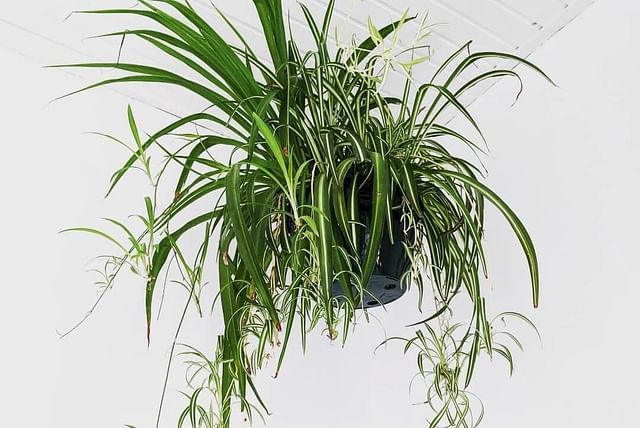
Pairing your Ficus Elastica with other plants can make it easier for you to take care of them, but also makes multiple plants look great together. When you're looking for companion plants, it's important to choose plants that have similar light and water needs. Here are some plants that grow well alongside your Ficus, along with their benefits:
1. Pothos (Epipremnum aureum)
Pothos is an excellent companion for Ficus Elastica. This vining plant thrives in similar light conditions, preferring bright, indirect light but can also tolerate lower light levels. Both plants enjoy moderate watering, allowing the top inch of soil to dry out between waterings.
The lush, trailing vines of pothos can create a beautiful contrast to the upright, broad leaves of the rubber plant, adding visual interest to your space. Pothos is also well-known for its air-purifying qualities, so they even help you breathe!
2. Dracaena
Dracaena varieties, such as Dracaena marginata or Dracaena fragrans, are another good match for your Ficus Elastica. They thrive in similar indoor conditions and appreciate bright, indirect light, allowing them to grow together. Dracaenas are also growing straight up and have thick stems, so if you're looking for different plants that have a similar vibe, these plants are a good match!
3. Spider Plant (Chlorophytum comosum)
Spider plants are charming companions for Ficus Elastica. Known for their air-purifying capabilities and ease of care, spider plants prefer bright, indirect light and enjoy slightly moist soil, just like your Rubber plant. Their leaves and small baby plants, give a nice contrasting texture to the large leaves of the ficus.
4. Peace Lily (Spathiphyllum)
Peace lilies can make a wonderful pairing with your Ficus as well. They thrive in similar light conditions and appreciate the humidity that often accompanies a healthy Ficus elastica. Peace lilies have elegant white blooms and glossy green leaves, which can contrast beautifully with the bold foliage of the Ficus.
Conclusion
Ficus Elastica is an eye-catching houseplant that requires a bit of extra care to ensure it thrives. With the right light, water, and pruning routine, you can keep your Ficus healthy and happy for years to come. Remember not to over prune as this could harm or shock your plant and be sure to keep it away from pets due to its toxic sap content. Now that you know how to take proper care of your Ficus Elastica, all that's left is to enjoy your new plant!
Share this plant care guide with your friends and family to help them take care of their Ficus Elastica in their house!
Thank you for reading this post! I hope it helps you to keep your plants healthy and beautiful! If you're looking for more guides on specific plants, you can always request a plant guide to get a guide for the plant you have trouble with.
Test your plant care knowledge
Quiz completed!
Want to learn more? Sign up for my newsletter to receive free tips in your inbox!
Sign up now!
